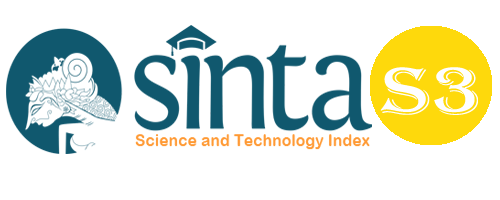Home Leisure Wear Recommendation on Social Media: Theory of Planned Behaviour Applied
Abstract
This research was conducted to see the consumer behavior of recommendation intention on social media to use home leisure wear with theory of planned behavior applied. This research can be a contribution for fashion industry and maximizing business strategies. The problem raised is how the attitude construct, subjective norm and perceived behavioral control influence intention to recommend home leisure wear on social media. The novelty of the research is intention to recommend using social media platforms and fashion products with home leisure wear specification. Structural Equation Modeling (SEM) was used to analyze the data obtained with the SmartPLS. Questionnaires in easy-to-understand language were distributed to 143 respondents who filled them out perfectly. There are three conclusions and two of them are rejected hypotheses. The subjective norm construct became the most influential construct in the intention to recommend home leisure wear. Further research is expected to take larger data, longer period and broaden the target characteristics of respondents.
Keywords
Full Text:
PDFReferences
Ajzen, I, & Madden, T. J. (1986). Prediction of goal-directed behavior: Attitudes, intentions, and perceived behavioral control. Journal of Experimental Social Psychology, 22(5), 453–474.
Ajzen, Icek. (1991). the Theory of Planned Behaviour. Organizational Behavior And HUman Decision Process, 50, 179–211. https://doi.org/10.1080/10410236.2018.1493416
Azizi, S. (2014). A Model of Factors Affecting Foreign Brand Trust. Journal of Competitiveness, 6(3), 20–31.
Bayu, D. J. (2021). Jumlah Pengguna Media Sosial di Dunia Capai 4,2 Miliar. Databoks.Katadata.Co.Id.
Bigne, E., Andreu, L., Hernandez, B., & Ruiz, C. (2018). The impact of social media and offline influences on consumer behaviour. An analysis of the low-cost airline industry. Current Issues in Tourism, 21(9), 1014–1032. https://doi.org/10.1080/13683500.2015.1126236
Boobalan, K., Nachimuthu, G. S., & Sivakumaran, B. (2021). Understanding the psychological benefits in organic consumerism: An empirical exploration. Food Quality and Preference, 87(March 2020), 104070. https://doi.org/10.1016/j.foodqual.2020.104070
Bronner, F., & De Hoog, R. (2011). Vacationers and eWOM: Who posts, and why, where and what. Journal of Travel Research, 50, 15 –26. https://doi.org/10.1177/0047287509355324
Brown, J. J., & Reingen, P. H. (1987). Social ties and word-of-mouth referral behavior. Journal of Consumer Research, 14, 350–362. https://doi.org/10.1086/209118
Chang, S. E., Shen, W. C., & Yeh, C. H. (2017). A comparative study of user intention to recommend content on mobile social networks. Multimedia Tools and Applications, 76(4), 5399–5417. https://doi.org/10.1007/s11042-016-3966-1
Cheng, S., Lam, T., & Hsu, C. H. C. (2006). Negative word-of-mouth communication intention: An application of the theory of planned behavior. Journal of Hospitality & Tourism Research, 30, 95–116. https://doi.org/10.1177/1096348005284269
Cheung, M. F. Y., & To, W. M. (2016). Service co-creation in social media: An extension of the theory of planned behavior. Computers in Human Behavior, 65, 260–266. https://doi.org/10.1016/j.chb.2016.08.031
Chin, W.W. (1998). The Partial Least Square Approach for Structural Equation Modelling. Modern Methode for Mahwah.
Chin, Wynne W. (1998). The partial least squares approach for structural equation modeling. Modern Methods for Business Research, April, 295–336.
Davis, F. D. (1989). Perceived Usefulness, Perceived Ease of Use, and User Acceptance of Information Technology. MIS Quarterly, 13(3), 319–340.
Fishbein, M., & Ajzen, I. (1975). Belief, Attitude, Intention, and Behavior: An Introduction to Theory and Research. Reading, MA: Addison-Wesley.
Fornell, C., & Larcker, D. (1981). Evaluating Structural Equation Models with Unobservable Variable and Measurement Error. Journal of Marketing Research, 18, 39–50.
Ghozali, I. (2014). Structural Equation Modelling: Metode Alternatif dengan Partial Least Square (PLS) Edisi 4. Universitas Diponegoro.
Hsu, C. L., & Lu, H. P. (2004). Why do people play on-line games? An extended TAM with social influences and flow experience. Information and Management, 41(7), 853–868.
Jain, S. (2020). Assessing the moderating effect of subjective norm on luxury purchase intention: a study of Gen Y consumers in India. International Journal of Retail and Distribution Management, 48(5), 517–536. https://doi.org/10.1108/IJRDM-02-2019-0042.
Khairifa, F. et al. (2019). The Relationship of Social Media Usage to the Satisfaction and Practice of Friendship (Silaturahmi) among Students of Universitas Sumatera Utara. Budapest International Research and Critics Institute-Journal (BIRCI-Journal). P. 575-589.
Kotler, P., Kartajaya, H., & Setiawan, I. (2021). Marketing 5.0: Technol- ogy for humanity. Wiley.
Maichum, K., Parichatnon, S., & Peng, K. C. (2016). Application of the extended theory of planned behavior model to investigate purchase intention of green products among Thai consumers. Sustainability (Switzerland), 8(10), 1–20. https://doi.org/10.3390/su8101077
Merlo, E., & Belfanti, C. M. (2021). Fashion, product innovation, and consumer culture in the late 19th century: Alle Città d’Italia department store in Milan. Journal of Consumer Culture, 21(2), 337–358. https://doi.org/10.1177/1469540519876005
Oklevik, O., Nysveen, H., & Pedersen, P. E. (2018). Influence of design on tourists’ recommendation intention: an exploratory study of fjord cruise boats. Journal of Travel and Tourism Marketing, 35(9), 1187–1200. https://doi.org/10.1080/10548408.2018.1487367
Seo, M. J., & Kim, M. (2019). Understanding the purchasing behaviour of second-hand fashion shoppers in a non-profit thrift store context. International Journal of Fashion Design, Technology and Education, 12(3), 301–312. https://doi.org/10.1080/17543266.2019.1611945
Susilawati, et al. (2020). Impact of COVID-19’s Pandemic on the Economy of Indonesia. Budapest International Research and Critics Institute-Journal (BIRCI-Journal). P. 1147-1156.
Taylor, S., & Todd, P. A. (1995). Understanding Information Technology Usage: A Test Competing Models. Information System Research, 6, 144–176.
DOI: https://doi.org/10.33258/birci.v4i4.2775
Article Metrics
Abstract view : 154 timesPDF - 51 times
Refbacks
- There are currently no refbacks.

This work is licensed under a Creative Commons Attribution-ShareAlike 4.0 International License.

This work is licensed under a Creative Commons Attribution-ShareAlike 4.0 International License.

_.gif)

















_.gif)



